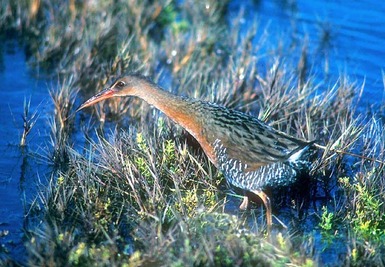 California Clapper Rail California Clapper Rail If the social sciences had a family crest, somewhere over the top the words “It’s complicated” would be scrawled in Latin. Social research and policy is full of examples of unintended consequences. But some things are just a good idea, right? For example, environmental management projects to remove invasive species? Not so fast. While invasive species can often cause a lot of damage in a local ecosystem, rapidly removing them can sometimes have unintended, negative consequences for the local environment you are trying to protect. A recent article in Science by Buckley & Han highlighted this issue, describing how invasive species often thrive in a new place because they are very successful at filling a niche in that ecosystem – sometimes much more successfully than the local species that usually fills that niche. They highlight an example in San Francisco Bay where an invasive cordgrass species (a hybrid of Spartina alterniflora) was being rapidly removed, but the native species (S. foliosa) it had displaced was not recovering fast enough to fill this niche. This resulted in declining populations of a local endangered bird, the California clapper rail, which had begun using the invasive hybrid for nesting. Another recent articled points out that these kinds of unintended consequences will be particularly prevalent when interconnections between the invasive and other native species are high and in late stages of invasion when the ecosystem functions performed by the native have been more or less subsumed by the invader. This is a familiar sounding situation for south Florida where we have more exotic species than anywhere else in the U.S. and are ranked pretty high globally as well – about a quarter of all fish, reptiles, birds, and mammals in south Florida are exotic. Some of these invaders have been here a long time and have become a major part of our landscape, others are relatively new. These interactions can become even more complex when you bring social science back into the mix and consider how people can use and become reliant on these invasive species as well. Buckley & Han discuss the need to take complex interactions and potential negative consequences into account when making management decisions about invasive species. They offer up a model by Lambert et al. for making these decisions that includes costs of restoration, eradication, and invasive damage. They quickly note however that the ability to monitor and evaluate these costs very from place to place with local resources and system complexity. It may be more complicated still, however. Putting on my social scientist hat, I would argue that even if we were able to transform these various metrics into dollar signs and calculate costs and benefits, decisions about what and how we want to restore a landscape often depends on what we value in that landscape and therefore how visible various parts of our natural world are to us (for a historical example see this blog post on alligator conservation in Florida). The impacts of invasive removal in San Francisco Bay were visible because they impacted a charismatic bird species whose population was being monitored. Our other impacts on our environment as we attempt to turn back the clock and restore habitats may be less apparent to us though they are always certainly there. This of course is not to say that we should not manage invasive impacts. The Nature Conservancy estimates that invasive species are second only to the development-fueled habitat destruction in damage done to Florida’s ecosystems. It is just interesting to note that though we have categorized something as “not belonging,” this does not mean that that species can’t weave it’s way into our nature. We may need to take this into account so as not to further injure our local flora and fauna.
0 Comments
Leave a Reply. |
Field Notes
Archives
July 2021
Categories |
|
Partner with us! We are always looking for new schools, scientists, and non-profit organizations to partner with. Please contact us here to start a conversation.
Hear from us! Sign up for our newsletter to hear about what is happening at Field School as well as upcoming offers and specials. |

 RSS Feed
RSS Feed